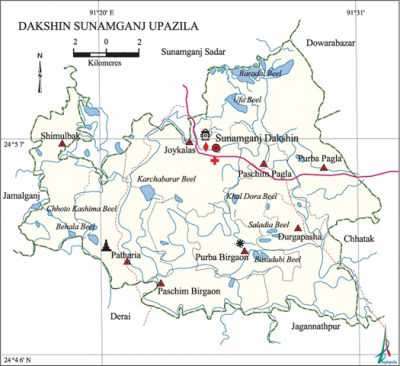Dakshin Sunamganj Upazila
Dakshin Sunamganj Upazila (sunamganj district) area 303.17 sq km, located in between 24°49' and 25°10' north latitudes and in between 91°14' and 91°27' east longitudes. It is bounded by sunamganj sadar and dowarabazar upazilas on the north, jagannathpur and derai upazilas on the south, Dowarabazar and chhatak upazilas on the east, jamalganj upazila on the west.
Population Total 183881; male 90997, female 92884; Muslim 166008, Hindu 17771, Christian 5, Buddhist 15 and others 82. Indigenous communities such as Hajang, manipuri and garo belong to this upazila.
Water bodies Noted beels: Baradal, Ufa, Karchabarar, Behala, Basadubi, Saladia.
Administration Dakshin Sunamganj Upazila was formed on 6 June 2006 comprising south part of Sunamganj Sadar.
| Upazila | ||||||||
| Municipality | Union | Mouza | Village | Population | Density (per sq km) | Literacy rate (%) | ||
| Urban | Rural | Urban | Rural | |||||
| - | 8 | 107 | 171 | 5181 | 178700 | 607 | 34.1 | 32.2 |
| Upazila Town | ||||||||
|
Area |
Mouza |
Population |
Density (per sq km |
Literacy rate (%) | ||||
| 6.54 | 1 | 5181 | 792 | 34.1 | ||||
| Union | ||||
| Name of union and GO code | Area (acre) | Population | Literacy rate (%) | |
| Male | Female | |||
| Joykalas 33 | 9585 | 18328 | 18508 | 33.3 |
| Durgapasha 11 | 9477 | 12025 | 11959 | 35.5 |
| Paschim Pagla 90 | 7896 | 9096 | 9212 | 37.9 |
| Paschim Birgaon 89 | 14912 | 7554 | 7760 | 35.5 |
| Patharia 61 | 8316 | 11535 | 12024 | 27.6 |
| Purba Pagla 94 | 6932 | 10405 | 10843 | 33.4 |
| Purba Birgoan 92 | 7818 | 7578 | 7907 | 31.0 |
| Shimulbak 78 | 9978 | 14476 | 14671 | 26.6 |
Source Bangladesh Population Census 2011, Bangladesh Bureau of Statistics.

War of Liberation Freedom fighters of the upazila had a direct encounter with the Pak army at Babnia village of Patharia union in August 1971. Freedom fighters also carried out operations in Sadarpur Bridge area, the place where Razakar Commander Abdul Sattar established a camp for his gang, Ganiganj, and the ferry landing stations at Ahsanmara and Dabar. A sculpture named “the Sculpture of a Freedom Fighter of Ahsanmara” has been established in the upazila.
For details: see দক্ষিণ সুনামগঞ্জ উপজেলা, বাংলাদেশ মুক্তিযুদ্ধ জ্ঞানকোষ (Encyclopedia of Bangladesh War of Liberation), বাংলাদেশ এশিয়াটিক সোসাইটি, ঢাকা ২০২০, খণ্ড ৪।
Religious institutions Mosque 150, temple 20.
Literacy rate and educational institutions Average literacy 32.3%; male 33.7%, female 30.9%. Educational institutions: college 1, secondary school 13, primary school 95, madrasa 5. Noted educational institutions: Pagla High School, Noakhali Saptagram High School, Ganinagar Shalagram High School, Dungria High School, Joykalas Ujanigaon Rashadia High School, Surma High School, Purba Pagla High School, Ujanigaon Govt. Primary School, Sadarpur Govt. Primary School, Dungria Govt. Primary School, Manikpur Govt. Primary School, Patharia Govt. Primary School, Ganiganj Govt. Primary School, Birgaon Govt. Primary School, Pagla Govt. Primary School, Ransi Govt. Primary School, Chikarkandi Govt. Primary School,' Jamya Ish. Haji Akram Ali Dakhil Madrasa, Amaria Islamia Alim Madrasa.
Cultural organisations Library 1, women's organisation 1, playground 38.
Main sources of income Agriculture 70.39%, non-agricultural labourer 3.69%, industry 0.49%, commerce 7.15%, transport and communication 0.52%, service 2.75%, construction 0.42%, religious service 0.37%, rent and remittance 3.54% and others 10.68%.
Ownership of agricultural land Landowner 43.72%, landless 56.28%.
Main crops Paddy, wheat, mustard, vegetables.
Extinct or nearly extinct crops Sesame, kaun, arahar, tobacco, etc.
Main fruits Mango, jackfruit, litchi, banana, guava, pineapple.
Fisheries, dairies and poultries Fishery 175, poultry 60, dairy 7.
Communication facilities Pucca road 56 km, semi-pucca road 20 km, mud road 205 km.
Extinct or nearly extinct traditional transport Palanquin and bullock cart.
Noted Manufactories Flour mill, ice factory, cold storage, fish processing centre and welding factory.
Cottage industries Blacksmith, pottery, bamboo and cane work.
Hats, bazars and fairs Hats and bazars are 20, most noted of which are Takur Bazar, Birgaon Bazar, Bangla Bazar, Patharia Bazar, Mina Bazar, Joykalas Bazar, Noakhali Bazar, Ganiganj Bazar.
Main exports Paddy, vegetables.
Access to electricity All the unions of the upazila are under rural electrification net-work. However 38.4% of the dwelling households have access to electricity.
Sources of drinking water Tube-well 93.5%, tap 0.1% and others 6.4%.
Sanitation 29.2% of dwelling households of the upazila use sanitary latrines and 60.4% of dwelling householss use non-sanitary latrines; 10.4% of households do not have latrine facilities.
Health centres Family welfare centre 5, health centre 2, clinic 17.
NGO activities Operationally important NGOs are brac, asa, proshika. [Rajib Mondal]
References Bangladesh Population Census 2001 and 2011, Bangladesh Bureau of Statistics.
